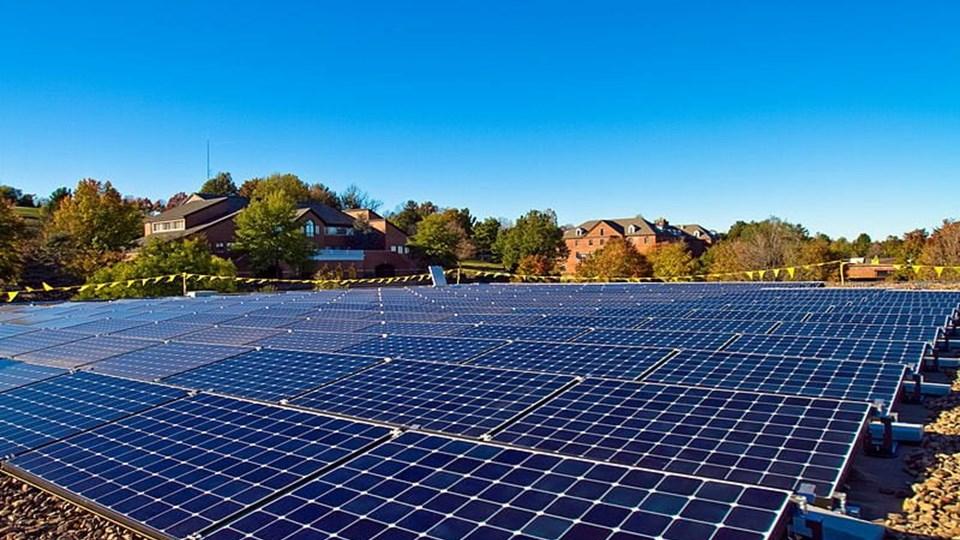Solar Power
Solar power is electricity produced by solar energy: the light and heat from the sun. Solar energy is one of the cleanest renewable energy sources available and is the largest current energy source for the globe.

Solar power can be used for multiple applications, which can be characterized as either active solar applications or passive solar applications:
Active Solar
- Concentrating Solar Power
- Solar Heating and Cooling
- Solar Photovoltaics
Passive Solar
- Solar Architecture
- Artificial Photosynthesis
Solar Power Types
There are two main categories of solar power technologies: active solar and passive solar.
Active solar technologies are used to directly convert solar energy into another form of useful energy, such as electricity or heat conversion. Three popular, yet very different technologies are described below.
- Concentrating solar power (CSP) consists of mirrors and lenses used to concentrate the sun’s light. This concentrated light creates temperatures that drive steam turbines or engines, which ultimately produce electricity. Since this technology is most cost-effective when used on a larger scale, CSP plants are commonly seen as energy suppliers to utilities. CSP plants consist of multiple designs.
- Solar heating and cooling produce heat from the sun’s thermal energy to provide hot water, heating and cooling, and pool heating. Although similar in design to PV systems, solar water heating collectors produce heat, while solar PV systems produce electricity. There are specific assemblies for the various solar heating and cooling technologies.
- Solar Photovoltaic (PV) energy directly converts the sun’s light into energy by solar PV panels. This system is used in a variety of applications today. Smaller-scale PV systems are commonly seen on rooftops or buildings, while larger-scale solar PV systems are associated with photovoltaic power stations, or solar parks. These PV power stations are located all around the world, and are the main solar technology used for electricity production.
Since PV power stations supply power at a utility level, PV panels are placed in a different fashion than those utilized by local users; a solar PV system consists of one or more PV panels, a DC/AC power converter (or inverter), electrical interconnections, and mounting components. Solar PV panels can be made out of multiple materials that affect the overall efficiency of the system. Keep in mind that as the efficiency of a solar panel increases, the cost increases as well. Below are a few of the main PV panel materials with their relative efficiencies.
| Solar PV Material | Efficiency (%) |
|---|---|
| Thin Film | 12 |
| Polycrystalline | 15 |
| Monocrystalline | 18-20+ |
Passive solar technologies take advantage of the sun’s light and heat without the use of any mechanical or electrical devices. Also termed “daylighting,” this method allows for the walls, windows and floors of buildings to collect the sun’s energy during winter months, and reject it during the summer months.
Key aspects of passive solar design include window placement, the use of thermal mass, and appropriate solar orientation. Examples are listed below:
- Large, south-facing windows allow for maximum sun exposure
- Open interior spaces allow sunlight to travel within an interior
- Correct building orientation as well as window placement and summer rooftop shading can allow for more or less sunlight to enter into a space depending on the specific season
- A trombe wall, which is a sun-facing wall, will absorb solar energy and release it to the interior over time.
- Thermal mass is a solid or liquid material that will store warmth and coolness until it is needed within a space. Thermal masses include water, brick, tile, concrete, clay and adobe.
Advantages of Solar Power
Energy Independence
Photovoltaic arrays provide the unique feature to promote energy independence of sites and environmentally friendly features that reduce our demand for natural resource production.
Unlimited Resource
Solar energy is a renewable energy that is based on the sun’s inexhaustible quantities.
No Pollution Produced
Solar panels do not pollute or emit greenhouse gases in its production or use.
Versatile
Solar energy can be used for a variety of functions and applications.
Ability for Additions
PV systems are modular and can be easily expanded upon or even transported in some cases.
No Cost After Installation
Like all renewable sources, solar energy is available at no cost once the infrastructure has been installed.
Things to Consider
Costs
Solar power comes at high costs. However, financial incentives including federal tax credits reduce the installation cost significantly. Furthermore, capital costs are lowering for larger-scale projects.
Fluctuation of Energy
Solar panels cannot continuously produce the same amount of energy needs throughout the year. Energy absorption is base upon time of year and the site’s location on the earth’s surface. Winter and wet seasons produce less sunlight than summer and dry seasons.
Organizations
- American Solar Energy Society
- Pennsylvania Solar Center
- Solar Energy Industries Association (SEIA)
- Solar Energy International
- Solar Electric Power Association (SEPA)
